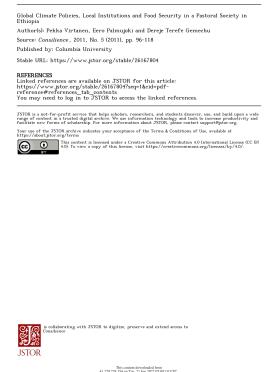Global Climate Policies, Local Institutions and Food Security in a Pastoral Society in Ethiopia
Global Climate Policies, Local Institutions and Food Security in a Pastoral Society in Ethiopia
This research explores how global climate policies are articulated within national policy priorities in Ethiopia, which shares many common features with other least developed countries (LDCs) in Africa. The focus of the study is on pastoral communities, which have been adversely affected by climate change, which is generally expected to hit developing countries harder than industrialized countries.This results since LDCs are less capable of mitigating or adapting to climatic changes due to poverty and high dependence on the environment for subsistence (UNDP, 2007). Recent research indicates, however, that in most cases of livelihood failure, climate is an exogenous trigger, while the deeper causes lie in social problems. The extent of the impact of climate change is determined by both the dependency of a national economy on climate-sensitive natural resources as well as the robustness or resilience of its social institutions to secure an equitable distribution in the face of such change (Barnett and Adger, 2007). Adaptation to climate change can be considered successful if it reduces the vulnerability of poor populations to existing climate variability while also strengthening their potential to anticipate and react to further changes (IGAD, 2007; UNDP, 2007).
In Ethiopia, pastoralism provides the main livelihood for close to 15 million people spread across seven regions of the country. Affected by unpredictable climatic conditions, recurrent conflicts and a generally inhospitable environment, the pastoralists are among the poorest of the poor in terms of disposable income, access to social services and general welfare. Human development indicators and poverty rates among pastoralists are uniformly worse than non-pastoralists in Ethiopia. Health coverage is sparse, with only 10 percent of the population immunized and more than 90 percent living in malaria-infested areas. In terms of education, both primary and secondary levels of enrolment remain at 20 percent and three percent, respectively (Bekele, 2008; MoFED, 2006). The upredictable climate, coupled with low levels of human development, mean that the expected effects of climate change are likely to exacerbate the problems of development in pastoral regions. These effects include increasing temperatures, a shift in rainfall patterns and distribution, as well as increased frequency of extreme weather events such as droughts and floods (Anderson et al., 2009; Nassef et al., 2009). The local pastoralists have hitherto been able to cope with recurrent droughts through the resilience of their traditional livelihood system, but presently marked signs of crisis are visible. The pastoral modes of sustenance are under excessive – largely externally created – pressure, and the number of people dropping out of the pastoral system has increased considerably (Pantuliano and Wekesa, 2008; Tache and Oba, 2008).

